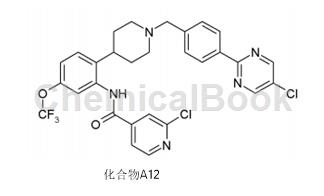Background and overview[1]
2-Bromo-5-trifluoromethoxyaniline is a chemical intermediate
Preparation[1]

A solution of 3-trifluoromethoxy-aniline (1.77g) in toluene (20ml) was treated with N-bromosuccinimide (1.87g) at ambient temperature and the reaction mixture was Stir for 2 hours, quench by adding water and extract the mixture with ethyl acetate (3x50ml). The combined organic extracts were washed with aqueous sodium bicarbonate solution (saturated), then dried over sodium sulfate and concentrated in vacuo. The residue was purified by silica gel chromatography (eluent: cyclohexane/ethyl acetate 95:5) to obtain 4-bromo-3-trifluoromethoxy-aniline (270 mg) and 2-bromo-5-tris Fluoromethoxy-aniline (1.45g), both characterized by mass spectrometry and NMR spectroscopy. 4-Bromo-3-trifluoromethoxy-aniline: MS (ES+) 256/258 (MH+); 1H NMR (400MHz, CDCl3) 3.5 (brs, 2H), 6.5 (d, 1H), 6.7 (s, 1H), 7.3 (d, 1H). 2-Bromo-5-trifluoromethoxy-aniline: MS (ES+) 256/258 (MH+); 1H NMR (400MHz, CDCl3) 4.2 (brs, 2H), 6.5 (d, 1H), 6.6 (s, 1H), 7.4 (d, 1H).
Apply [1]
Can be used to prepare an insecticidal compound.
2-Chloro-N-(2-{1-[4-(5-chloro-pyrimidin-2-yl)-benzyl]-piperidin-4-yl}-5-trifluoromethoxy- The preparation of phenyl)-isonicotinamide starts from 2-bromo-5-trifluoromethoxy-aniline.

Compound A12 has pesticidal/insecticidal properties. The test was carried out as follows: Spodoptera littoralis (Egyptian cotton leafworm) Cotton leaves were placed on agar in a 24-well microtiter plate and sprayed with the test solution at an application rate of 200 ppm. After drying, the leaves were infested with 5 L1 larvae. After 3 days of treatment (DAT), samples were examined for mortality, feeding behavior and growth regulation. Compound A12 provides at least 80% control of Spodoptera exigua:
Heliothis virescens (tobacco caterpillar): Place the eggs (0-24 hours old) on the artificial bait in a 24-well microtiter plate, and use a pipette to remove the test solution. Treatment with an application rate of 200ppm (concentration in the hole is 18ppm). After the 4-day incubation period, samples were examined for egg mortality, larval mortality, and growth regulation. Compound A12 provides at least 80% control of Heliothis virescens:
Diamondback moth (Plutella xylostella): Use a pipette to remove the test solution, and treat the 24-well microtiter plate (MTP) with artificial bait at an application rate of 200ppm (the concentration in the well is 18ppm). After drying, the MTPs were infested with L2 larvae (7-12 per well). After the 6-day incubation period, samples were examined for larval mortality and growth regulation.
Compound A12 provides at least 80% control of diamondback moth (Plutella xylostella):
Diabrotica balteata (corn rootworm): Use a pipette to remove the test solution, and treat the 24-well microtiter plate (MTP) with artificial bait at an application rate of 200ppm (the concentration in the well is 18ppm) ). After drying, the MTPs were infested with larvae (L2) (6-10 per well). After the 5-day incubation period, samples were examined for larval mortality and growth regulation. Compound A12 provides at least 80% control of Diabrotica balteata:
Main reference materials
[1] CN201080030402.6 Pesticide compounds

 微信扫一扫打赏
微信扫一扫打赏

